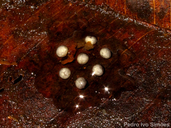|
Description
Males 14-17 mm, females
16-18 mm. The dorsal coloration has
different tones of brown. A dark brown
lateral stripe runs from the snout to midbody.
There are blue-white dots below
the lateral stripe and on the toes. Males
have lateral expansions on the third
finger during the breeding season. The
vocal sac of males is whitish to dark gray.
The throat region of females is white.
Juveniles have a dark head, and light
brown on the upper surface of the body. Distribution and Habitat
Country distribution from AmphibiaWeb's database: Brazil, Suriname
Found
throughout the Reserva Florestal Adolpho Ducke in Brazil.Life History, Abundance, Activity, and Special Behaviors
The species is
terrestrial and diurnal. Adults feed
mainly on termites, flies and beetles.
Juveniles eat mainly collembolans and
mites. Reproduction occurs between
November and March, with a peak in
January. Females deposit about 3-6
eggs out of water in rolled or doubled
fallen leaves, where the tadpoles
develop to metamorphosis. Adult
males are territorial, and tend the eggs
and tadpoles. Comments
Colostethus sp. are
similar, but have a continuous dark brown
lateral stripe from the snout to the
cloaca, forming a circle around the body,
an orange-brown dorsum, and gray hind
legs. Juvenile Adenomera andreae and
Eleutherodactylus fenestratus lack the
dark brown lateral stripe.
Originally submitted by: Albertina P. Lima, William E. Magnusson, Marcelo Menin, Luciana K. Erdtmann, Domingos J. Rodrigues, Claudia Keller, Walter Hödl (first posted 2007-11-14)
Edited by: Kellie Whittaker (2009-06-16)Species Account Citation: AmphibiaWeb 2009 Anomaloglossus stepheni <https://amphibiaweb.org/species/1611> University of California, Berkeley, CA, USA. Accessed May 31, 2025.
Feedback or comments about this page.
Citation: AmphibiaWeb. 2025. <https://amphibiaweb.org> University of California, Berkeley, CA, USA. Accessed 31 May 2025.
AmphibiaWeb's policy on data use.
|
